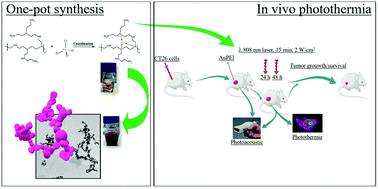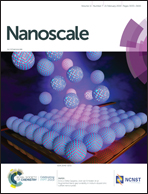Polyethyleneimine-assisted one-pot synthesis of quasi-fractal plasmonic gold nanocomposites as a photothermal theranostic agent†
Abstract
Gold nanoparticles have been thoroughly used in designing thermal ablative therapies and in photoacoustic imaging in cancer treatment owing to their unique and tunable plasmonic properties. While the plasmonic properties highly depend on the size and structure, controllable aggregation of gold nanoparticles can trigger a plasmonic coupling of adjacent electronic clouds, henceforth leading to an increase of light absorption within the near-infrared (NIR) window. Polymer-engraftment of gold nanoparticles has been investigated to achieve the plasmonic coupling phenomenon, but complex chemical steps are often needed to accomplish a biomedically relevant product. An appealing and controllable manner of achieving polymer-based plasmon coupling is a template-assisted Au+3 reduction that ensures in situ gold reduction and coalescence. Among the polymers exploited as reducing agents are polyethyleneimines (PEI). In this study, we addressed the PEI-assisted synthesis of gold nanoparticles and their further aggregation to obtain fractal NIR-absorbent plasmonic nanoaggregates for photothermal therapy and photoacoustic imaging of colorectal cancer. PEI-assisted Au+3 reduction was followed up by UV-visible light absorption, small-angle X-ray scattering (SAXS), and photo-thermal conversion. The reaction kinetics, stability, and the photothermal plasmonic properties of the as-synthesized nanocomposites tightly depended on the PEI : Au ratio. We defined a PEI-Au ratio range (2.5–5) for the one-pot synthesis of gold nanoparticles that self-arrange into fractal nanoaggregates with demonstrated photo-thermal therapeutic and imaging efficiency both in vitro and in vivo in a colorectal carcinoma (CRC) animal model.

- This article is part of the themed collection: International Year of the Periodic Table: Precious metals for cancer treatment


 Please wait while we load your content...
Please wait while we load your content...